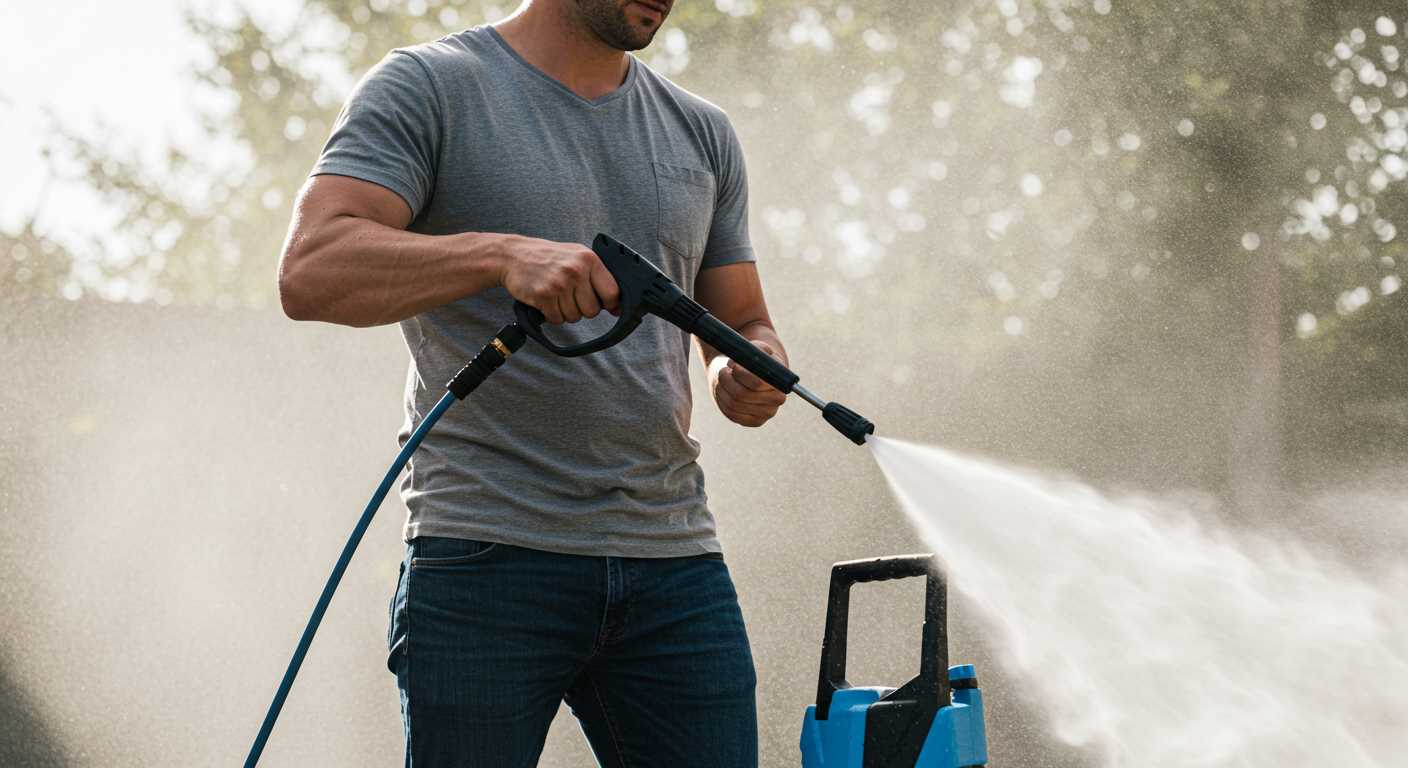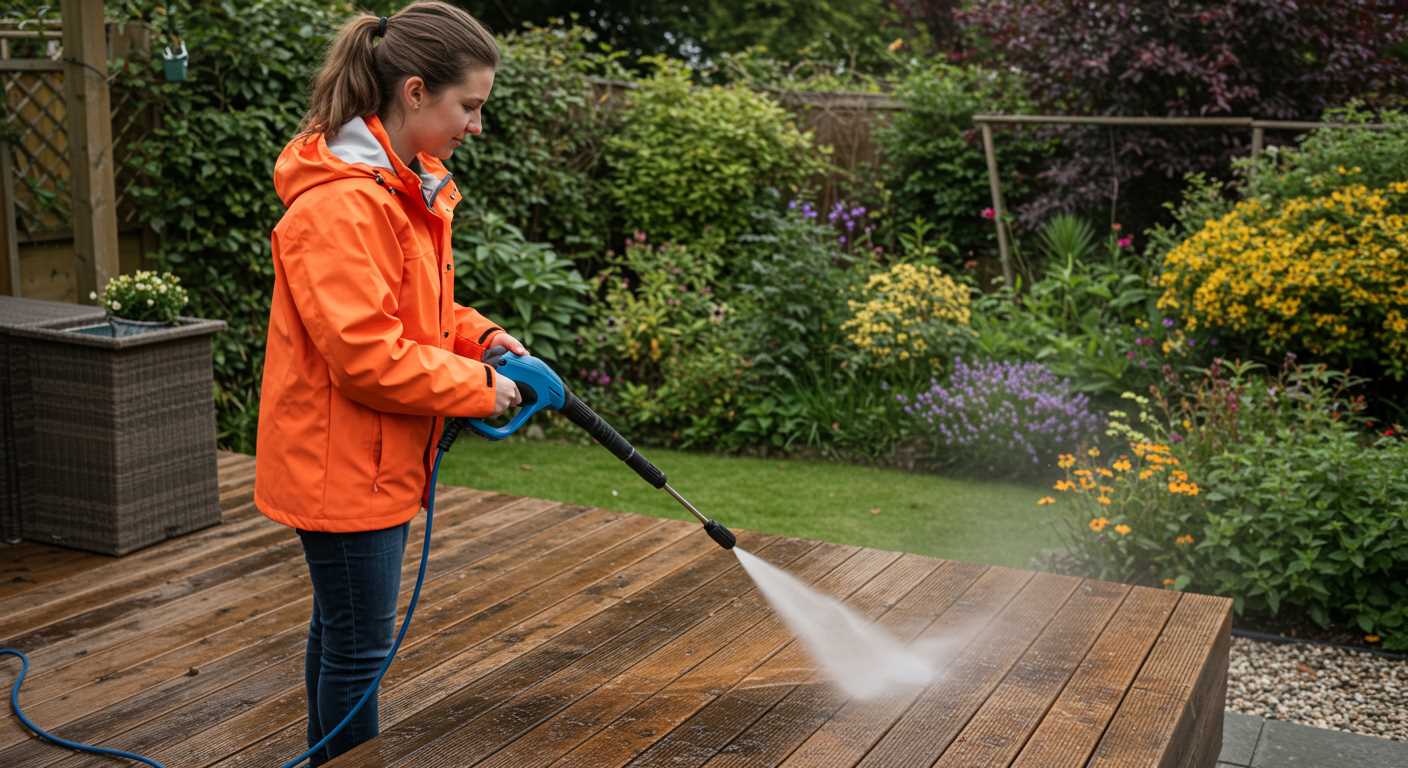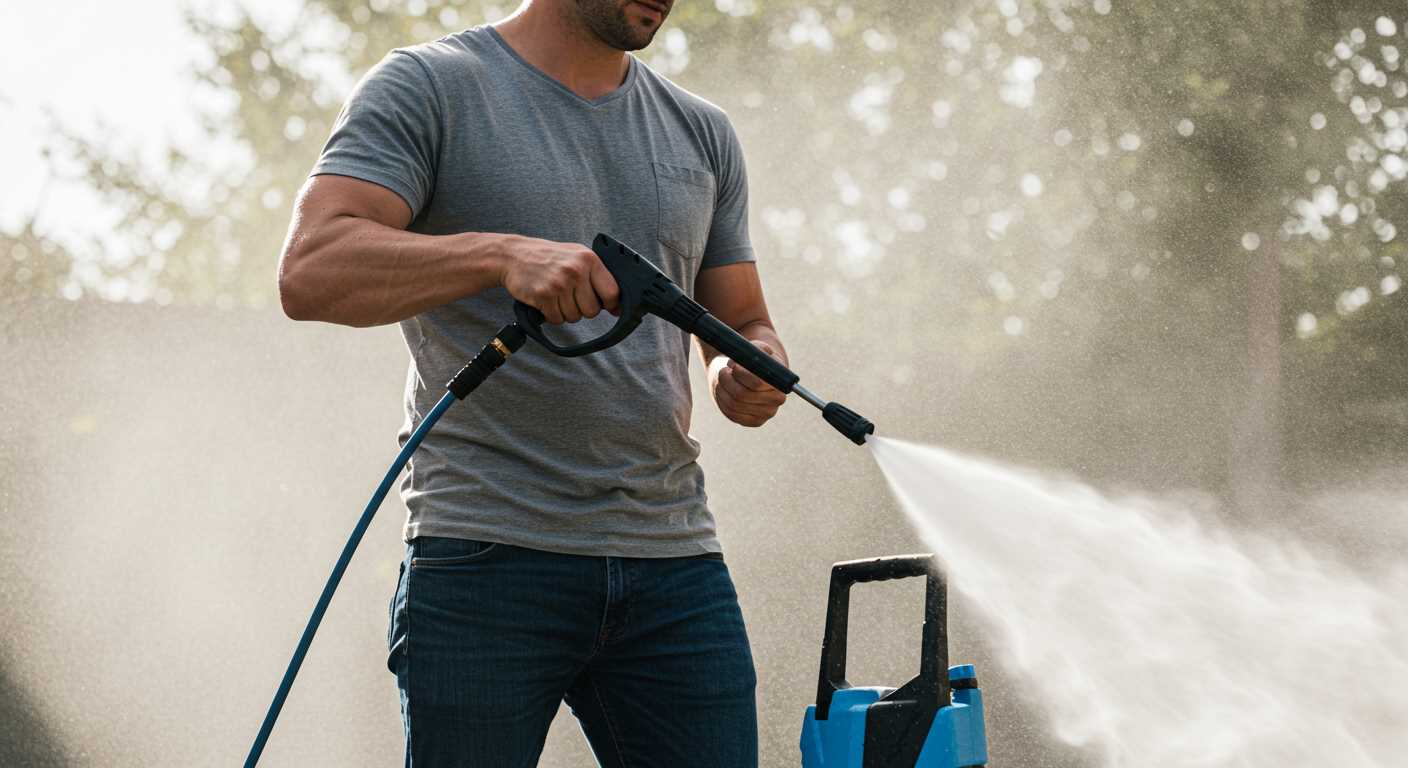




Utilising a high-powered cleaning device for automotive maintenance can yield outstanding results. In my years of experience with various models, I’ve found that the right approach and technique make all the difference. Begin by selecting a nozzle with a wider spray pattern to prevent damage to the paintwork while still removing dirt and grime effectively.
One common mistake is starting too close to the surface. Maintaining a distance of around 18-24 inches ensures that the force of the water does not chip or strip the paint. I recall the time I misjudged the distance and ended up with a few unsightly marks on my own vehicle. Lesson learned: always keep that safe space!
Pre-soaking with a dedicated automotive detergent can enhance the outcome. I often apply the soap using a foam cannon attachment, allowing it to dwell for a few minutes before rinsing. This method significantly loosens stubborn contaminants, making the subsequent rinsing much easier and more thorough.
Don’t forget to pay attention to the wheels and undercarriage. Many high-pressure devices come with special attachments for these areas, which are often neglected but can hide significant amounts of grime. Incorporating this step into the routine can lead to a much cleaner overall appearance and extend the life of various components.
Can You Clean Your Vehicle Using a High-Pressure Device?
Absolutely! Using a high-pressure device can be a great way to maintain the appearance of your vehicle. However, it’s crucial to approach the task with care to avoid damage. From my experience, keeping a safe distance of at least 60 cm from the surface helps prevent chips and scratches. The nozzle type also matters; a fan spray is preferable for wider coverage without intense force.
Technique Matters
Start from the top and work your way down. This method utilises gravity, ensuring that dirt flows downwards instead of re-depositing on already cleaned areas. Focus on sections: wash the roof, then the windows, and proceed to the sides and bumpers. Pay special attention to the wheel arches and lower panels where grime accumulates. A rotating brush attachment can be beneficial for stubborn spots, but always test it on a small area first.
Considerations for Optimal Results
Use a detergent specifically formulated for automotive use. Avoid household cleaners, as they may contain chemicals that could harm the finish. Dilute the detergent according to the manufacturer’s instructions and apply it before rinsing. Rinse thoroughly to ensure no residue remains, which could lead to streaks or discolouration. Afterward, a soft cloth or chamois can help dry the surface, preventing water spots.
In my years of working with various models, I’ve noticed that maintaining the right pressure setting is key. Most vehicles do well with a setting between 1200 to 1900 PSI. Higher pressures can be tempting but can cause more harm than good. Always prioritise the integrity of the paintwork over a quick clean.
In summary, harnessing a high-pressure device for vehicle maintenance can yield impressive results if done correctly. Just remember to keep your distance, select the right attachments, and utilise appropriate cleaning products for the best outcome.
Choosing the Right Pressure Washer for Car Cleaning
Select a model with a pressure rating between 1200 and 1900 PSI. This range offers enough power to remove dirt without damaging sensitive surfaces. I recall a colleague using a machine rated at 3000 PSI, which resulted in paint damage. A lower setting prevents such mishaps.
Opt for an electric variant if convenience matters. They are quieter, lighter, and easier to manoeuvre. I’ve found that electric units excel in providing steady pressure without the hassle of gas refills. A portable electric device fits well into any garage space.
Look for a unit with adjustable nozzles. The versatility of changing spray patterns is invaluable. I often switch from a wide spray for initial rinsing to a narrow jet for stubborn grime. This adaptability makes a noticeable difference in the cleaning process.
Consider models with built-in soap dispensers. This feature allows for the application of cleaning agents without the need for separate equipment. My favourite model has a soap nozzle that mixes detergent perfectly, ensuring a thorough wash without extra effort.
Check the length of the hose and power cord. A longer hose enables movement around the vehicle without repositioning the unit repeatedly. I once struggled with a short hose, constantly shifting the washer, which was both frustrating and time-consuming.
Don’t overlook weight and portability. A lighter machine makes transport easier, especially if you need to move it around your property. I remember lugging a heavy model up and down my driveway; it was exhausting. Choose a model with wheels for effortless mobility.
Finally, consider customer reviews and brand reliability. I’ve tested various brands, and certain companies consistently deliver robust performance and good customer support. Reading user experiences can provide insight into a machine’s long-term durability and efficiency.
Understanding Pressure Settings for Safe Cleaning
When working with a high-pressure unit, always aim for a lower setting, ideally between 1200 to 1900 PSI. This range effectively removes dirt without damaging delicate surfaces. I recall a time when a friend opted for a 2500 PSI setting, thinking it would provide a better result. The outcome? A chipped paint job and a hefty repair bill.
Adjusting the spray nozzle also plays a significant role. A wider angle, such as 25 to 40 degrees, diffuses the force, making it gentler on finishes. I’ve seen many people make the mistake of using a narrow nozzle on a car, resulting in scratches. Trust me, a wider spray is your friend here.
Distance from the surface is critical. Keep the nozzle at least 2 feet away to prevent any unintended damage. I often demonstrate this with a simple test: hold the nozzle closer and watch the difference in impact. That extra distance can be the line between a clean finish and costly repairs.
For stubborn grime, consider applying a car-safe detergent first. Let it sit for a few minutes before rinsing. I’ve had great success using this method, especially on vehicles that haven’t seen a wash in months. Just remember to rinse thoroughly to avoid any residue.
Always remember to rinse from top to bottom. Gravity plays a part, and this method ensures dirt flows downwards rather than getting pushed into already cleaned areas. I’ve often seen others start from the bottom, which only leads to frustration and a longer cleaning time.
Lastly, never forget to check the manufacturer’s guidelines for specific recommendations. Each vehicle comes with its own set of requirements, and following those helps maintain its appearance and value. I’ve learned the hard way that ignoring these can lead to long-term issues.
Essential Accessories for Car Washing with a Pressure Washer
Investing in the right tools can elevate the experience of maintaining a vehicle’s appearance. Over the years, I’ve experimented with a variety of accessories that enhance efficiency and effectiveness during the cleaning process. Here are some must-have items that I found invaluable.
Foam Cannon
A foam cannon is a game changer for any enthusiast. It attaches to the end of the lance and creates a thick layer of foam that clings to surfaces. This not only helps lift dirt but also provides ample lubrication, reducing the risk of scratches. When selecting a foam cannon, ensure compatibility with the model, and use a quality car shampoo for the best results. My personal favourite was a model that allowed adjustable dilution, giving me control over how much cleaning solution to use based on the level of grime.
Soft Brush or Mitt
Using a soft brush or wash mitt is indispensable. These tools gently agitate the foam and dirt without risking damage to the paint. I prefer a wash mitt made of microfibre for its gentle touch and ability to hold suds. One time, I used a brush with stiff bristles, thinking it would be effective on tougher stains, but it ended up scratching the surface. Always opt for a soft, non-abrasive option for a safer wash.
Don’t overlook the importance of a good quality hose and nozzle as well. A strong, flexible hose ensures easy manoeuvrability, while a nozzle with adjustable settings allows for versatility in water flow, catering to different cleaning needs. These accessories combined can transform a routine wash into a thorough, satisfying experience.
Preparing Your Vehicle for Pressure Washing
Before starting the cleaning process, ensure all loose items are removed from the interior and exterior. This includes any personal belongings, mats, and antennas. I once made the mistake of forgetting to take off a small GPS device, which ended up getting soaked and malfunctioned. Save yourself the hassle.
Inspect for Damage
Check for any scratches, dents, or areas of peeling paint. If there are any weak spots, avoid direct spraying to prevent further damage. I remember a time when I used too much force on a vehicle with previously damaged paint, resulting in even more flaking. Always assess before proceeding.
Rinse Loose Dirt
A quick rinse with a garden hose can help remove larger debris before applying high-pressure cleaning. It makes a significant difference. I often do this step to prevent scratching the surface during the main wash. It’s a small effort that pays off immensely.
| Preparation Step | Details |
|---|---|
| Remove Loose Items | Take out all personal belongings and accessories. |
| Inspect for Damage | Check for any paint damage or weak spots to avoid direct spray. |
| Initial Rinse | Use a garden hose to rinse off loose dirt and debris. |
Lastly, consider applying a protective film or wax after washing. I’ve found that using a best audio scrubber program for any stubborn spots can enhance the shine and protect against future dirt accumulation. Preparation is key for achieving optimal results.
Step-by-Step Guide to Pressure Washing Your Car
Begin by selecting a sheltered area to avoid direct sunlight and wind. This helps prevent soap and water from drying too quickly, leading to streaks.
Rinse the vehicle thoroughly using a low-pressure nozzle attachment. This removes loose dirt and debris, making the next steps more effective. Aim the spray at a distance of around 2-3 feet to prevent damage.
Mix a suitable car shampoo with water in a bucket according to the manufacturer’s instructions. Use a foam cannon if available; it creates a thick lather that clings to surfaces, breaking down grime effectively.
Apply the soapy mixture evenly across the surface, starting from the top and working downwards. This method ensures that dirt flows downwards and doesn’t get trapped on the lower panels.
Allow the suds to dwell for a few minutes but don’t let it dry. Check the foam cannon or nozzle settings to ensure a gentle application. Afterward, rinse thoroughly from the top down, ensuring all soap is removed.
For stubborn spots, use a soft brush or a microfiber cloth dipped in the soapy solution. Avoid using abrasive materials that can scratch the paintwork.
After rinsing, dry the surface using a microfiber drying towel. This step is crucial to eliminate water spots and streaks. A blower can also be handy for drying hard-to-reach areas.
Inspect and clean the wheels and tyres separately. Use a dedicated wheel cleaner and a brush to tackle brake dust and grime. Rinse thoroughly to remove any residue.
Finally, apply a wax or sealant for protection. It not only enhances shine but also provides a barrier against environmental contaminants.
Follow these steps for a thorough and safe washing experience, ensuring a sparkling finish every time.
Common Mistakes to Avoid When Using a Pressure Washer
Avoiding common pitfalls can make a significant difference in the outcome of the cleaning session. Here are the top mistakes to steer clear of:
- Using Too High a Pressure: Many believe that higher pressure equates to better results. However, excessive force can damage paintwork or trim. Always start with the lowest setting and gradually increase if necessary.
- Neglecting Distance: Holding the nozzle too close to the surface can lead to scratches or paint damage. Maintain a distance of at least 2-3 feet from the vehicle’s surface to ensure safety.
- Skipping Pre-Wash: Directly applying high pressure without pre-soaking can be ineffective. Use a gentle soap solution beforehand to loosen dirt and grime, making the process smoother.
- Forgetting to Rinse: After applying soap, ensure to rinse thoroughly. Residue can lead to streaks and spots on the surface, detracting from the overall finish.
- Ignoring Accessories: Not using the right attachments can hinder the cleaning process. Invest in a soft brush or foam cannon for better application and effectiveness.
- Washing in Direct Sunlight: This can lead to soap and water drying too quickly, resulting in water spots. Choose a shaded area or cooler time of day for optimal results.
- Neglecting Safety Gear: Always wear protective eyewear and gloves. High-pressure water can pose risks; ensuring safety should be a priority.
- Not Reading the Manual: Every machine has its own specifications and guidelines. Familiarising yourself with the user manual can prevent many errors.
As a side note, if you’re also into maintaining bikes, consider exploring pressure washers for bikes for tailored options.
Post-Cleaning Care: Drying and Waxing Your Vehicle
After the washing process, drying is crucial to prevent water spots and streaks. Microfibre towels work wonders; they absorb moisture efficiently without scratching the surface. I prefer using a large, plush microfibre drying towel, which covers more area and speeds up the task. Gently blot the surface rather than dragging the towel across the paint to protect the finish.
Once dried, applying a wax layer significantly enhances protection and shine. I’ve experimented with various wax types, and I lean towards a synthetic polymer wax for its durability and ease of application. It can last for several months, providing a shield against environmental contaminants. Always follow the manufacturer’s instructions for the best results.
Use an applicator pad to apply wax evenly. Work in small sections to ensure thorough coverage. Afterwards, buff the area with a clean microfibre cloth to achieve that glossy finish. In my experience, waxing not only enhances the appearance but also simplifies future cleaning, as dirt and grime won’t adhere as easily.
Regular maintenance, including drying and waxing, will keep your vehicle looking pristine. I’ve seen the difference it makes over time; a little effort goes a long way in preserving the paint and overall condition.
Environmental Considerations When Pressure Washing
Using high-pressure equipment for vehicle maintenance can significantly impact the environment. First off, the choice of detergents matters. Opt for biodegradable soaps that break down naturally, reducing harm to local ecosystems. I recall a day I used a standard detergent, only to find out later it had a detrimental effect on my garden. Switching to eco-friendly products made a noticeable difference, both for my conscience and my surroundings.
Water Usage and Conservation

Water consumption is another critical factor. High-powered devices can use up to 50% less water than traditional methods. However, it’s essential to be mindful of water runoff. Using a nozzle that creates a focused spray can limit excess water wastage. I often set up a rain barrel to collect runoff during cleaning sessions, which I then repurpose for watering plants. It’s a simple yet effective way to conserve resources.
Protecting Local Wildlife
During any washing process, consider the proximity to natural habitats. Chemicals can seep into the ground or flow into storm drains, posing a risk to local fauna. To mitigate this, I always ensure that my washing area is away from drainage systems. Additionally, creating a barrier with absorbent mats can help capture spills and prevent them from reaching vulnerable areas. It’s a small change that can have a substantial impact on local wildlife.
In essence, being mindful of the products, water use, and surroundings transforms routine maintenance into a responsible practice. Each step taken ensures not just a clean vehicle, but a healthier environment as well.
When Not to Use a Pressure Washer on Your Vehicle
There are specific scenarios where utilising a high-powered cleaning device may cause more harm than good. Here are the situations to avoid:
- Delicate Surfaces: Avoid using it on soft-top convertibles or vehicles with custom paint jobs. The force can damage the fabric or strip the paint.
- Electrical Components: Areas housing sensitive electronics, such as under the hood, should be off-limits. Water intrusion can lead to expensive repairs.
- Wheel Wells: Directing a concentrated stream into wheel wells may dislodge dirt but can also expose components to excessive water, leading to rust over time.
- High-Pressure Setting: Using maximum pressure on any part of the vehicle is risky. It can chip paint or even cause dents on softer materials.
- High Winds: Operating in windy conditions can lead to water spraying in unintended directions, potentially harming painted surfaces or getting inside the vehicle.
- During Freezing Temperatures: Water can freeze in crevices, causing damage or freezing the locks. Wait for milder conditions for washing.
- After an Accident: If the vehicle has recently been in a collision, it’s best to consult a professional before attempting any cleaning to avoid further damage.
In my experience, I’ve seen too many enthusiasts rush into cleaning without considering these factors, only to regret it later. Always assess the condition of the vehicle and its components before proceeding. A cautious approach ensures longevity and preserves the vehicle’s appearance.






.jpg)

.jpg)


